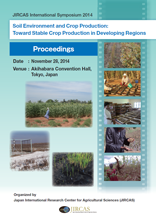Sustainable Technologies for Crop Production under Salt-Affected Soil in India

Salt-affected soils adversely affect the livelihood security of people in more than 100 countries,
as they occupy about 831 million ha (Mha) all over the world. Out of this area, 397 Mha (47.8%) are
saline, while 434 Mha (52.2%) are sodic. On the regional scale, Asia, the Pacific and Australia
together have the largest area (30%) under salt-affected. The area under salt-affected soils in India is
estimated to be 6.73 Mha spread over a number of states across the country. Similarly, 25% of the
ground water resources in the country are saline and brackish. Certain states like Rajasthan and
Haryana located in the western part of the country are endowed with 84 and 62% of poor quality
ground waters, respectively. Continuous use of such waters for irrigation to agricultural crops is bound
to increase the problem of salinity and sodicity in India. Introduction of irrigation without making
proper provision for drainage is the major cause for the development of salinity in canal commands.
The projections indicate that the country will have 11.7 Mha area affected by salinity and sodicity by
2025. From reclamation and management point of view, the salt-affected soils in India are broadly
placed into two categories: (i) sodic soils, and (ii) saline soils. The alkali soils in general are
characterized by high soil pH up to 10.8, high exchangeable sodium per cent (ESP) up to 90, low
organic carbon, poor infiltration and poor fertility status. These soils are dominated by sodium
carbonate and sodium bi-carbonate salts. On the other hand, the saline soils have higher electrical
conductivity (>4 dS m
-I
), low ESP 15%) and low pH 8.5). The dominant salts in saline soils
include chlorides and sulphates of Na, Ca and Mg (Abrol et.al.1988).
Central Soil Salinity Research Institute, Karnal, has developed and standardized several
location-specific technologies for reclamation and management of saline and sodic soils. This paper
provides a brief insight into some of the technologies, which involve intervention of farming system
approach in Canal command and its effects on reducing the negative impact of water logging and
sodicity, development of strategies for crop production through efficient, balanced and integrated use
of inputs including amendments and fertilizers and minimization of the cost of reclamation (Sharma
and Chaudhari 2012); resource conservation strategies in sodic land agriculture; improvement in crop
production through the use of salt-tolerant varieties and carbon sequestration. In recent past, the fruit
crops and agro-forestry systems have been identified as alternate land use systems for reclamation and
management of sodic soils. Cultivation of identified halophytes, salt tolerant crop varieties and grasses
with no or reduced doses of amendments are other attractive biological reclamation options.
Sodic soil land reclamation technology through chemical amendments developed by the
institute has become quite popular and about 2.0 million ha area has been reclaimed with the adoption
of this technology. The reclaimed area alone is contributing approximately 17 million tonnes of paddy
and wheat annually. Besides, sodic land reclamation activity in the last 42 years generated one time
employment of about 26 million person-days in the first year of reclamation. The reclaimed lands now
generate an annual employment of 76 million person-days each year for rice-wheat cultivation.
| 刊行年月日 | |
|---|---|
| 作成者 | Dinesh Kumar Sharma |
| 著者キーワード |
Salt-affected soils land reclamation saline soils sodic soils crop production |
| 公開者 | Japan International Research Center for Agricultural Sciences |
| オンライン掲載日 | |
| 号 | 2014 |
| 開始ページ | 120 |
| 終了ページ | 131 |
| 権利 | Japan International Research Center for Agricultural Sciences |
| 言語 | eng |
